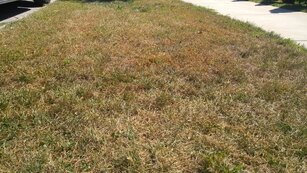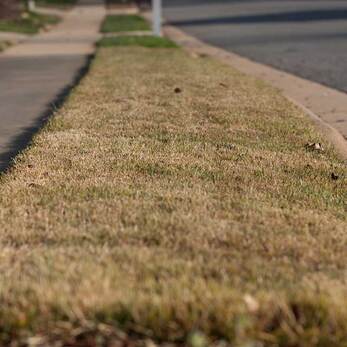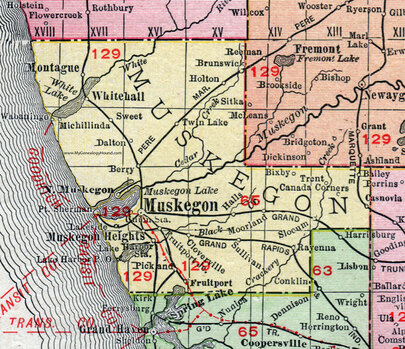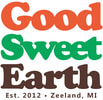 Overseeding your lawn is a really important part of having a thicker, healthier and greener lawn with less weeds. It really isn't difficult to do, but it does require some knowledge to get the most germination for your buck. Read on to learn the why, what, how, when and where of overseeding your lawn. Keep in mind, we're a West Michigan-based company, so our recommendations are targeted for this region. Why should you overseed your lawn? Nature loves diversity. On the flip side, it hates a monoculture. Our efforts, as 21st century American homeowners, to create a monoculture in our lawns goes directly against what nature wants. So, left to its own devices, your lawn is going to have a lot of diversity popping up. You might better know this diversity as "weeds." You don't want weeds (and you don't want to use herbicides)? Put down grass seed and over time, it will push out the weeds. Now you've got three options when facing the idea of lawn diversity: 1) Let it happen. Just unconditionally accept the diversity popping up in your lawn and love it as you would love a pasture growing wild in the countryside. 2) Drop chemical herbicides onto it. This is how golf courses and baseball fields roll. They put down chemical herbicides to both prevent and kill weeds. It's also how most Americans have been conditioned by the chemical lawn industry to approach their lawns. ("Weeds are BAD!") Or (our favorite choice) 3) Employ better lawn management practices. This means fertilizing with an organic fertilizer to get richer soil that turf actually wants to grow in. It means watering deeply a couple times a week to encourage deeper roots. It means setting your mower to its highest setting. And it means overseeding your lawn once, and maybe even twice, every single year. The importance of overseeding comes from the fact that weed seeds can find even the smallest gap in your lawn to germinate and establish roots. If you can put down grass seed before the weed seeds can germinate, you'll have grass growing there instead of something you don't want Now, if you're going to opt for an organic lawn, you're going to have to accept Option 1 to a certain degree. Going organic, you should always expect (and even strive for), at minimum, 10% diversity in your lawn. Anything less than that just isn't healthy. If your lawn is more than 90% grass, you're opening yourself up to pest infestation, fungal infection, higher water bills, etc. But allowing some other stuff (clover, dandelions, violets, etc.) to find a home on your lawn will help keep things balanced and healthy. And telling yourself that some diversity is good for your lawn will even help you relax a bit and enjoy your lawn more, without the stress of striving for perfection weighing you down all summer. I only recommend Option 2 (chemical herbicides) as a very last resort, and as an organic lawn guy, I don't make specific chemical recommendations. But if your yard has become more than 50% weeds, and you're not happy with how it looks, I'd advise researching ways to start over by killing off what's there, and doing a complete re-seed or re-sod. If you've just got areas that are becoming infested with weeds (creeping charlie, for instance), at the very most, spot treat with an herbicide to kill of the stuff in that area, then re-seed. Again, these are last resorts in my opinion. Pulling up weeds and overseeding is a much more sustainable option But keeping weeds out isn't the only reason you should overseed. Does your lawn do better in certain parts of your yard than others? Maybe your shady backyard is thick and lush, while your sunny front yard is looking thin and brown during the hot summer months. Maybe the grass under the shade of a tree looks good, while the grass that doesn't receive shade looks terrible. If so, there's a chance your yard was initially seeded or sodded with the wrong type of grass. If a shade-loving grass was put down in an area that never gets shade, it's always going to struggle. Likewise, if a sun-loving grass gets put in a shady area, it's not going to thrive either. So what's a homeowner to do to fix this sun/shade problem? Overseed with a sun/shade grass seed mix.
0 Comments
 Potatoes are a garden gem that too many gardeners avoid. They are simple to grow and so delicious right from the garden. But if you decide to do it, don’t believe the internet type about growing potatoes in towers as this method is more work and does not yield you more potatoes. You can grow them in straw or you can plant and forget them. Potatoes will even grow in 5 gallon buckets! If this garden gem isn’t on your must grow list add it to your list for next year. When to plant? Keep in mind that potatoes are cool weather growers. It's best to plant in early spring. In fact, planting potatoes two to three weeks before your last frost date will produce the most satisfactory results. For Michiganders, that means the last week of April through the first week of May. If you live in West Michigan, and are looking for help growing things like potatoes in your garden, we'd love to work with you. Click to learn more about our Garden Pro service.  Spring is past, and we’ve now transitioned into the hotter, dryer days of summer. That means fresh tomatoes, berries, peppers, roses...and brown grass. Yep. It’s nature, people. For those of us living in West Michigan (actually, everyone north of Kentucky), we have what’s called “cool weather turf.” That means once the temps regularly hit the 80s, the grass goes to sleep-- just like it does in winter. It’s not dead-- let me reiterate that point: Brown grass isn't necessarily dead grass. It’s just resting and building up energy for the next growing season, which happens to be autumn. Cool weather turf greens up and grows when temps range between 60 and 75. That’s the sweet spot you have in the spring and fall, and that’s why you’re constantly mowing in May, June, late September and early October. So what’s an ecologically-friendly homeowner to do during these crispy summer months? The most-environmentally-friendly answer is: Nothing. Let it sleep. Grass can go about 10-14 days (depending on how high the temps go) without water before it actually dies. Once you get into the third week without any water on your lawn, give it a good, deep watering early in the morning. A good way to tell the difference between dead and dormant grass? Give it a good tug. If it comes out easily, it's dead and it ain't coming back. If it stays put, it's just dormant and doing exactly what God intended in the summer. If you don’t want it to go too dormant (and get too brown) you can give it a good deep watering whenever it gets too brown for your own comfort level. Maybe you want your grass to stay as green as possible. That means you could be watering every third day. Maybe you just want to keep it from going dormant; that might mean you water once a week. Whatever you decide, the key is to water deeply-- 30-60 minutes whenever you turn the sprinklers on. Deeper waterings mean the turf's roots grow deeper into the ground. And that means your grass will be able to find water deeper in the soil. But here’s a little secret: When you treat your lawn organically, your turf won’t get as crispy as a lawn treated with synthetic chemicals during dormancy. Why? The soil is healthier and can tolerate heat and drought better. It can hold on to water better. Plus, those longer waterings mean your turf’s roots have grown deep into the ground and are better able to find water, even when it doesn’t rain. Bottom line. Your grass is supposed to go dormant, and turn brown, twice a year: winter and summer. During those times, it’s building up carbohydrates for the next growing season. However, to keep it from going too dormant, give it a deep watering on occasion, or whenever you want to see a little more green color on your lawn. Avoid short, daily waterings. Regardless of how much you water, it's just natural for your grass to have some brown in it in the summer. So relax, and enjoy the season! It'll be fall before you know it, and your grass will be green again.  This is the first in a Q&A blog series on healthy organic turf. If you have a question for Good Sweet Earth's lawn guy, Steve, shoot him an email at [email protected], and include "Ask the Lawn Guy" in the subject line. So the question of "How much should I water?" is a frequent one, which is why I've decided it tackle this one first in our "Ask the Organic Lawn Guy" series. And here's a simple answer: Water as often as you'd like, to keep your turf as green as you'd like, but make sure you water for at least 30 minutes at a time (ideally 45-60). Read on for a more-nuanced answer. First, we need to talk about turf in Michigan. We're in what's called a "cool-weather turf zone." That means our turf grows when it's cool, and it goes dormant when it's hot and when it freezes. And contrary to popular belief, grass shouldn't be bright green in the middle of summer, and you probably aren't going to be mowing it twice a week either. Michigan turf grows and greens in the spring and the fall. Then during the summer and winter, it gets brown and stops growing while it stores up carbohydrates for the next growing season. So, all that brown grass you see in the summer? It ain't dead. It's sleeping. If you don't mind having brown, crispy grass during the months of July and August, letting it sleep is probably the best thing you can do for your lawn. It'll have much more vigor and density in the fall. That being said, turf shouldn't go for more than three weeks (two in especially hot conditions) without water. So even if you go the dormancy route with your turf, you should still put the sprinklers on every two to three weeks (if there's been no rain). And when you do put the sprinkler on, let it go for about 45-60 minutes per zone. This will allow the water to go deeper into the ground, which will force the roots to grow deeper as well. This will give you stronger and more drought-resistant turf. But what if you don't want brown crispy grass all summer? What if you like to have some soft green turf to play on and admire? Then my advice to you is to let it get as brown as you're comfortable with, and then put the sprinklers on for 45-60 minutes. For some people, this might mean watering twice or three times a week. For others, it might mean once every 10 days. I don't have a hard and fast rule for how often you should water. Just do it when you think your lawn's getting too brown for your own comfort. If you're able to go 15 days between waterings (and let the grass go into a dormancy), great! If the thought of crispy turf makes you feel a little uneasy, go as many days as you can without watering, and then let the sprinklers fly. The only rule I have is to water for at minimum 30 minutes, but ideally 45-60, depending on how your soil can handle that amount of water (you don't want puddling). The one thing you do NOT want to do is a 10-minute watering. This will mean the water never goes very deep into your soil, and neither does your turf's root zone. And that's bad news. I've talked to too many customers who water their lawn every morning, seven days a week, all summer long, for 5-15 minutes a day. This is not effective for healthy turf. Watering at mid-day or in the evening is also bad. Why? When you water at mid-day, you lose a lot of moisture to evaporation. And watering at night can create a breeding ground for fungus on your grass. Mornings are the best time of day to sprinkle. Now, I have to mention that there's a real technical answer that turf professionals like to give when asked how much to water a lawn, and it includes the number of inches of water you should be applying, and then putting out coffee cans in your yard while you sprinkle in order to measure the amount of water, etc. But most of us aren't managing a golf course. If you go with what feels comfortable for your lawn, watch out for over-watering (puddles), avoid short watering periods, and avoid mid-day/evening waterings, you'll be fine. So to sum up: In the spring and fall, you can probably rely on rain to do all the watering your lawn needs, but if you do turn the sprinklers on, water deeply (at least 30 minutes). In the summer, go as long as you're comfortable going between waterings. If you don't mind grass that's a little brown, letting your turf go dormant is ideal for it's long-term health. Otherwise, turn the sprinklers on for about 45 minutes in the morning whenever you see your turf getting too brown for your own comfort.  Good news, Muskegon County residents! Good Sweet Earth isn't just serving the counties of Kent, Allegan and Ottawa anymore. Starting in 2019, we're expanding our service area north along the lakeshore to cities and townships in Muskegon County. If you live in Muskegon, Norton Shores, Whitehall, Roosevelt Park, Casnovia, Fruitport, Montague, Ravenna, or any neighboring community, and you'd like to feed your turf and soil organically, we'd love to come out and give you a free consultation for lawn care. But why go organic on your lawn? First, healthy grass comes from healthy soil. Synthetic chemical fertilizers kill your soil, which in turn kills your turf and makes it overly reliant on chemicals. Dead soil is also a breeding ground for weeds and disease. Organic fertilization focuses on feeding your soil and developing a healthy ecosystem of bacteria, fungi, worms and other life below the surface of your yard. We use vermicompost (nutrient-rich compost made by earthworms), microbial tea (a liquid rich in microbes to help break down organic matter in your soil), and all-natural slow-release fertilizers. Second, many people in the United States have made the switch to buying organic produce, yet continue to dump chemicals on their lawn and garden. There's a real disconnect there. If you're concerned with how your food is grown on a farm, you should be even more concerned with how your grass (and garden) are grown in your own yard. Third, synthetic chemicals are destroying our ecosystem. These chemicals leach into our watersheds, they kill the life found in our lakes, rivers and streams, they cause algae blooms, and ultimately introduce poisons into our environment. Organic soil management practices can reduce the effects of climate change by helping soil hold on to carbon more effectively. This type of healthy soil management doesn't have to be limited to farms, it needs to start right in each of our yards. In fact, lawns cover more acreage in the United States than any other crop. That means the management practices adopted by homeowners could have a larger impact on our nation's soil and climate than the actions of our farmers. If you live in Kent, Ottawa, Allegan or Muskegon Counties in West Michigan, and you'd like to learn more about organic lawn care for your own home, give us a call at 616-594-0693 or email us at [email protected]. |
